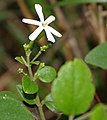| jasmine | |
|---|---|
 | |
| Jasminum sambac | |
| Scientific classification | |
| Kingdom: | Plantae |
| (unranked): | Angiosperms |
| (unranked): | Eudicots |
| (unranked): | Asterids |
| Order: | Lamiales |
| Family: | Oleaceae |
| Tribe: | Jasmineae |
| Genus: | Jasminum L. (1753) |
| Type species | |
| Jasminum officinale L. + | |
| Species | |
| More than 200 species, see List of Jasminum species Sources: ING,[1] CPN,[2] UniProt[3] | |

A double-flowered cultivar of Jasminum sambac in flower with an unopened bud. The flower smells like the tea as it opens.
[edit] Cultural importance and other information
Jasmine is the national flower of the following countries:
- Indonesia, where the variety Jasminum sambac is the "puspa bangsa" (national flower), and goes by the name "Melati Putih". It is the most important flower in wedding ceremonies for ethnic Indonesians, especially in the island of Java.
- Pakistan, where Jasminum officinale is known as the "Chambeli" or "Yasmine" is the national flower.
- Philippines, where it is known as "Sampaguita", and is usually strung on garlands which are then used to adorn religious images.
[edit] As a weed
Jasminum fluminense, which is sometimes known by the inaccurate name "Brazilian Jasmine", is an invasive species in Hawaii and Florida[13]. J. dichotomum, also called Gold Coast Jasmine, is also an invasive weed in Florida.[14][edit] Gallery
Jasmine bud in Chennai. This variety produces large flowers, but too few to be commercially viable. | Jasminum sambac flowers harvested for Malligai - Raama Baanam | ||








No comments:
Post a Comment